- 14/10/10
- 2,725
- 100
- 63
First and foremost, I chanced upon this fantastic write on another forum and thought it would be very beneficial to the members here..so I am compiling the information and opinions found and placing them in this thread for reference and more discussions..
In no way am I claiming any credit or ownership of the content (description and/or images)..all information provided here can be and have been found on the whole wide web..
 The Rolex crown is actually very amazing in its construction and design. It is the one element of the watch that the owner has complete control over.
The Rolex crown is actually very amazing in its construction and design. It is the one element of the watch that the owner has complete control over.
Using the crown the owner of the watch has the ability to set the time on the watch as well as the date. In the first position, the owner of the watch also has the ability to manually wind the watch. It is during this operation that the Rolex can fall victim to external elements entering the watch. These elements can be dirt as well as water.
There are safeguards that can protect the interior of the watch, provided that they are still in good working condition. These safeguards consist of small rubber gaskets. Some of these gaskets are located within the crown itself and others are located inside of the case tube that fits into the side of the Rolex watch case. These gaskets are very small and don't cost much to keep in good condition. To help them perform better, most are lubricated with a silicone lubricant. This lubrication also allows the crown to operate more freely as the owner makes adjustments to the watch.
Some Rolex case tubes and crowns will only have one gasket each. These are usually found in the dress style watches. Other Rolex watches that are used for diving will have more gaskets located in the case tube. The picture shows a typical Rolex diver watch. The crown has only one gasket deep within the crown. The case tube has two internal gaskets, one external gasket and one that fits between the case tube and the outside wall of the machined case. The typical gasket arraignment is indicated in red.
Below are some detailed diagrams showing the different Rolex crowns and the gasket placement. Also shown on the left side of each picture is the Rolex case tube. The case tube is very important and is what the crown screws onto. The base of the Rolex case tube is threaded to match the threads which enter the side of the Rolex watch case. The case tube needs to be very secure in it fitting to the watch case. The case tube really takes a beating, and as is often the case, will need to be replaced when the watch is serviced.

The word Ranuras in Spanish means Grooves.



Most later model Rolex crowns show the newer version of the crown emblem. What is important to note are the markings located under the crown. These markings will tell you if the crown on your watch is either a Twinlock or a Triplock crown. In addition to the type of crown will be a series of dots or as shown, a single line dash. These dots and dashes will tell you the metal content of the crown on your Rolex. The chart above explains these markings. The English to Spanish translation is shown above the chart.
The Rolex crown to the owner of the watch only appears to be a single unit. Not including the crown gasket, the crown is actually made using four parts. There is the large crown that is used to set the time, change the date, or wind the watch. Attached to this are three more parts. There is a spring, the tube that goes into the case of the watch, and the part that the stem screws into. This part engages the small spring inside the tube of the crown. The entire crown can be taken apart. The part that attaches to the stem has two small flats that are machined into it. This part is the one that engages the spring.
When the crown is unscrewed from the case tube, the spring forces the crown out so that it engages two slots on the crown sleeve or tube. This makes it possible to use the crown to set the time, wind the watch or change the date. When the crown is pushed back into the watch, these parts disengage which then allows the crown to be screwed down upon the case tube.
This secures the case, and if all the gaskets are working properly, water and dirt will stay out of the case.
Here are some additional images of the '704' monobloc crown with a 7030 tube..
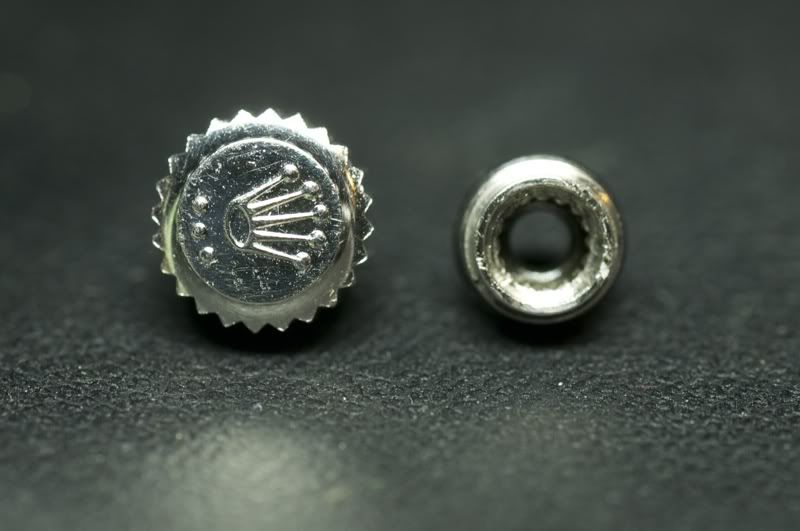
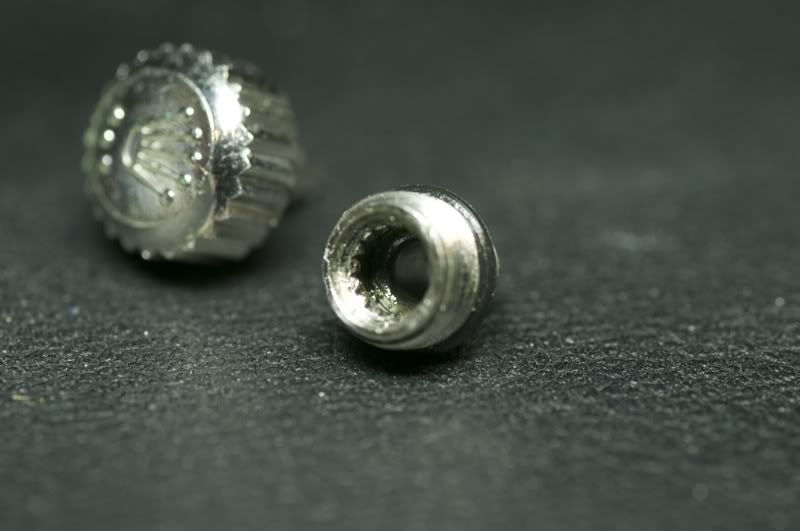

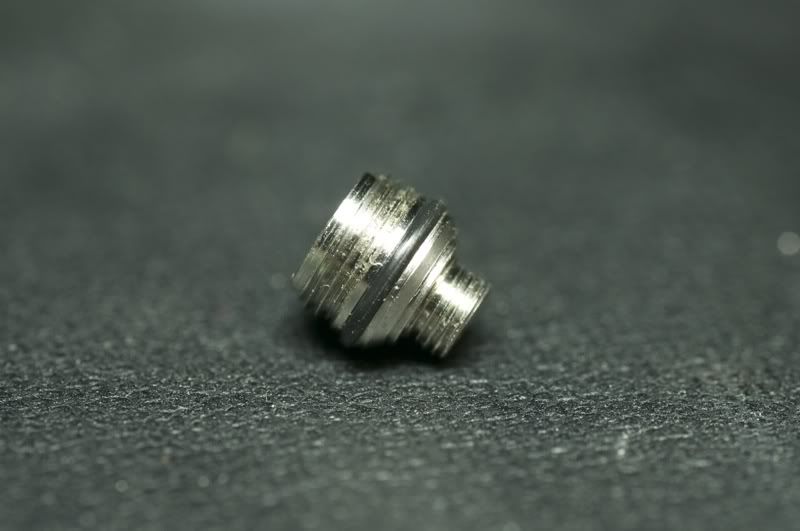
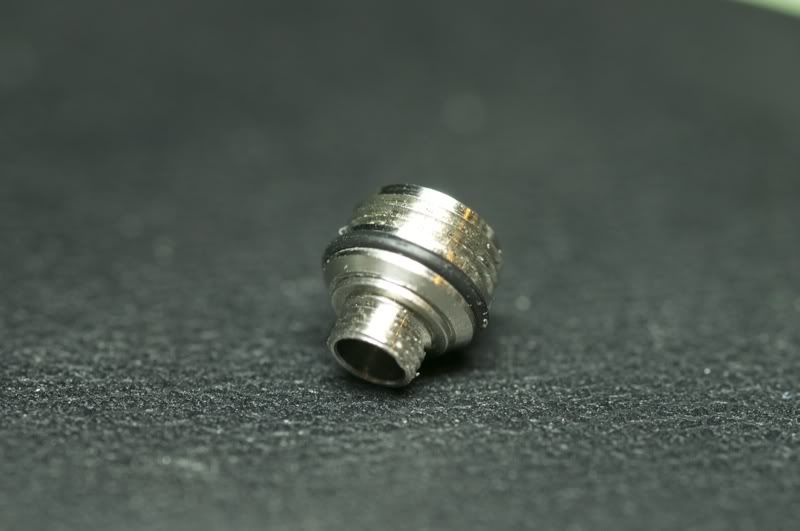
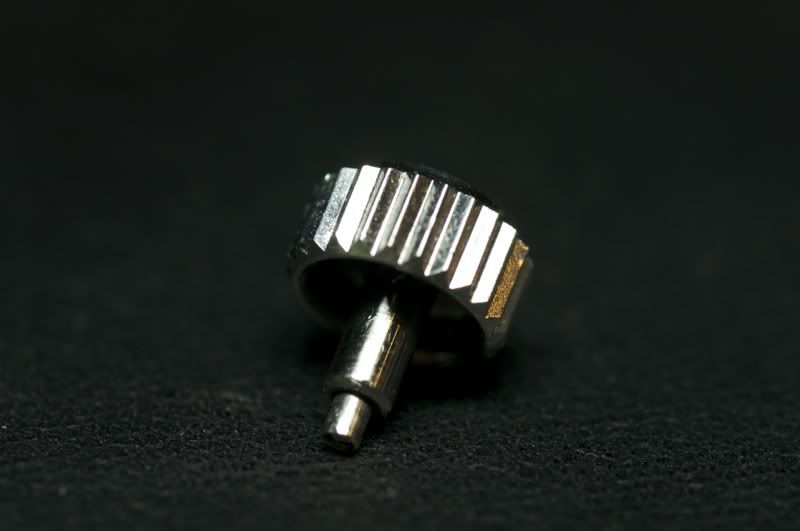
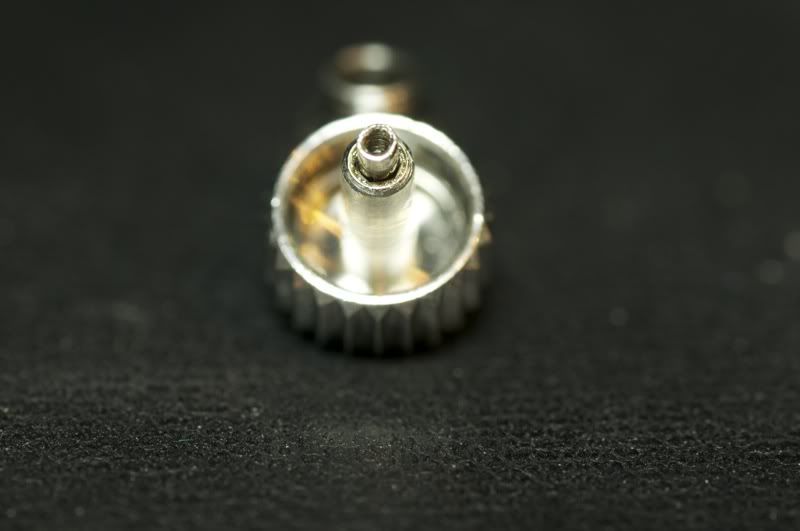
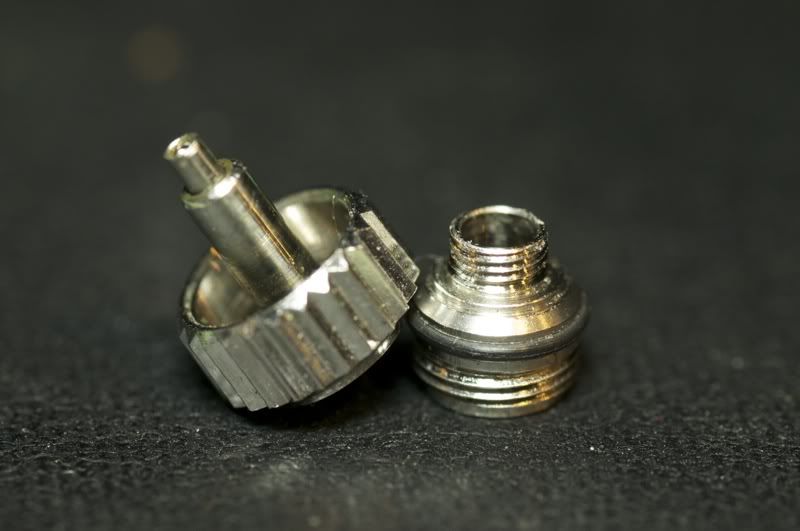
Below are a 702(Left) and 703(Right):


Essentially, both are of a wrapped style, where you have the core crown that is wrapped in an SS shell. You can see the crimping at the inner edge of the crown/serrations.
The 702 is an older style 'Triplock'- It is missing the exterior gasket on the tube, and is instead flanged at the end like so:

As such, the threading for the crown goes all the way to the opening.
The 703 has the exterior gasket on the tube and hence only has threading that goes to the halfway point on the interior of the crown. This is to clear the gasket.
Both crowns have long style coronets, whereas the 704 monobloc has the short, squat coronet like you have.
Here are some additional pics to illustrate the difference in the threading of both 702, 703 and 704 crowns:
702:

703:
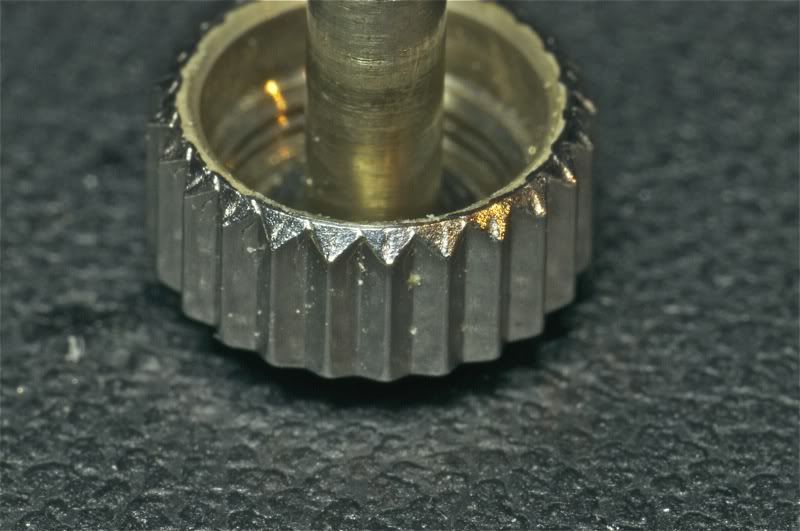
704:
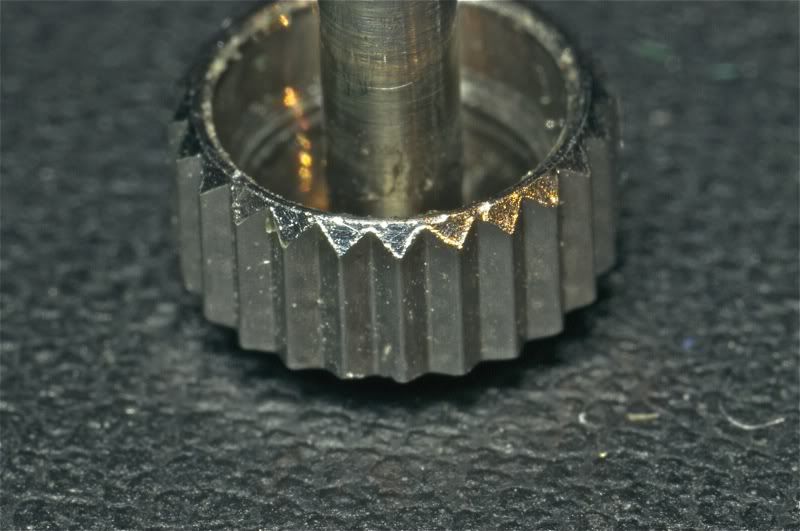
Well, the 704 crown supercedes the 703. It fits the 7030 tube just fine (as it's meant to).
24-7030-0 is just the p/n for the tube that goes with the 24-703 crown.

The 7030 tube (and aftermarket 7030 tubes) should fit the '704' crown just fine.
Note distance between bottom of crown & dots
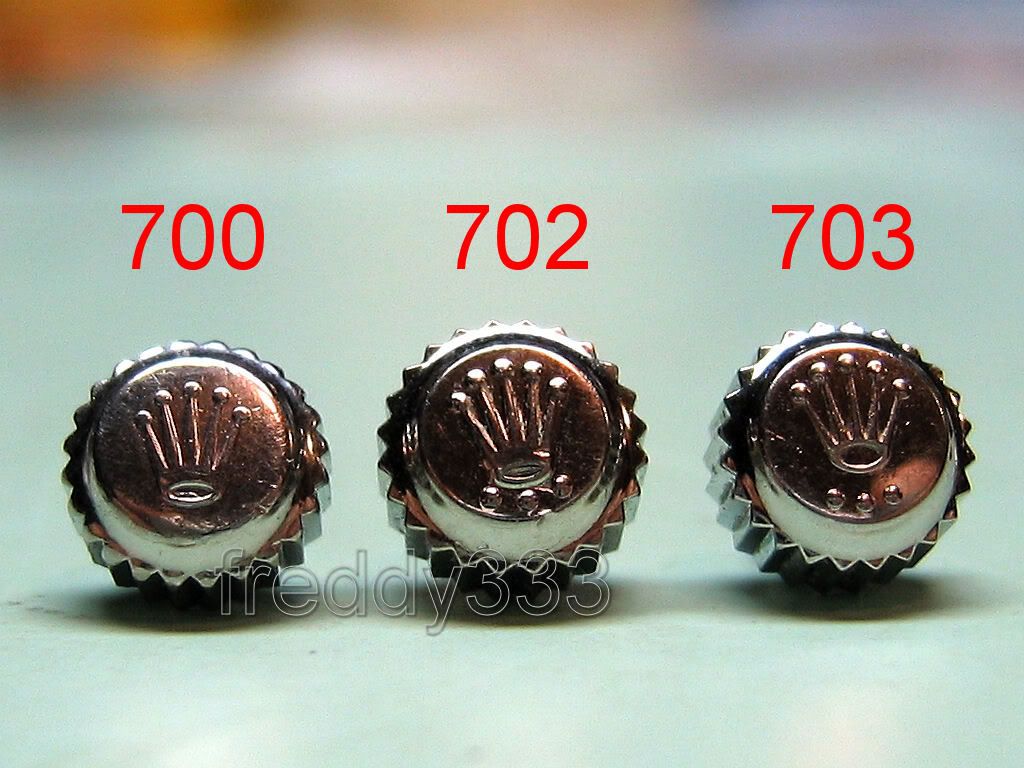

*edit:
The above should read (left to right): 700, 703, 704
More info on the different 7xx crowns from vrf:

--crown 700 ( twinlock , first equipment from 1959 to around the very late 60s ):
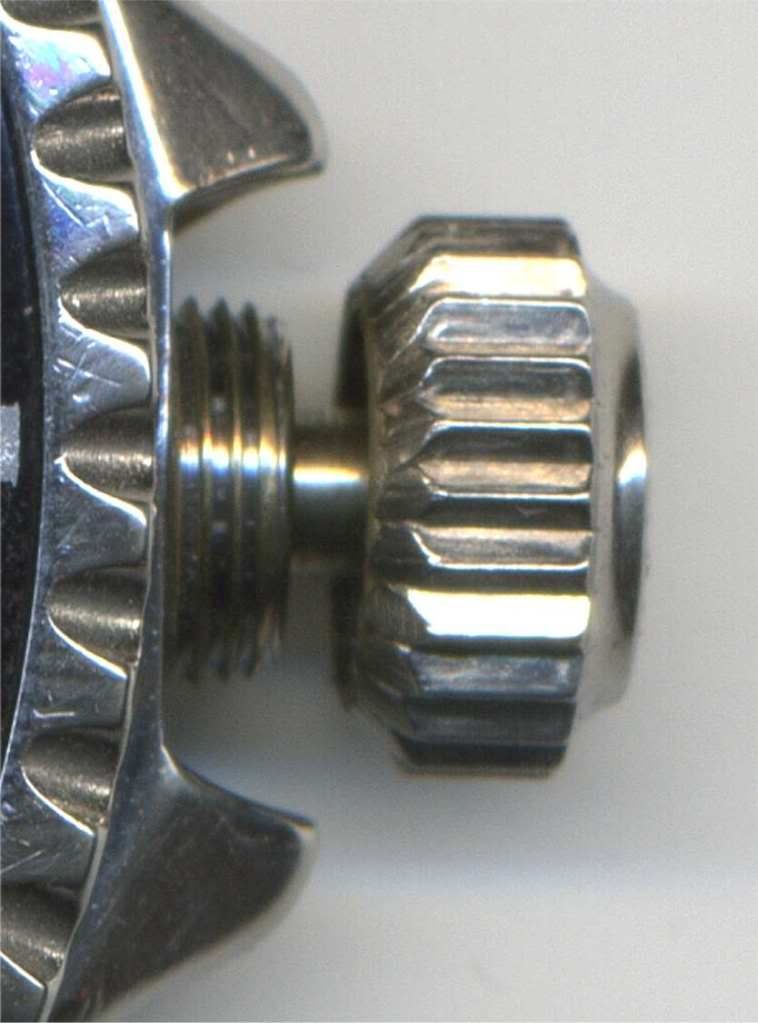
--crown 702 ( triplock without external rubber gasket , first equipment after the previous up to the early 80s ) :

--crown 703 ( triplock with external rubber gasket, first equipment from 1982 circa up to the present days (also known as 704)):

Hope this will shed some light onto what crowns to get when you are upgrading your reps or getting parts for your gens..
:cheers:
In no way am I claiming any credit or ownership of the content (description and/or images)..all information provided here can be and have been found on the whole wide web..
Technical Aspects of the Rolex Crown.

Using the crown the owner of the watch has the ability to set the time on the watch as well as the date. In the first position, the owner of the watch also has the ability to manually wind the watch. It is during this operation that the Rolex can fall victim to external elements entering the watch. These elements can be dirt as well as water.
There are safeguards that can protect the interior of the watch, provided that they are still in good working condition. These safeguards consist of small rubber gaskets. Some of these gaskets are located within the crown itself and others are located inside of the case tube that fits into the side of the Rolex watch case. These gaskets are very small and don't cost much to keep in good condition. To help them perform better, most are lubricated with a silicone lubricant. This lubrication also allows the crown to operate more freely as the owner makes adjustments to the watch.
Some Rolex case tubes and crowns will only have one gasket each. These are usually found in the dress style watches. Other Rolex watches that are used for diving will have more gaskets located in the case tube. The picture shows a typical Rolex diver watch. The crown has only one gasket deep within the crown. The case tube has two internal gaskets, one external gasket and one that fits between the case tube and the outside wall of the machined case. The typical gasket arraignment is indicated in red.
Below are some detailed diagrams showing the different Rolex crowns and the gasket placement. Also shown on the left side of each picture is the Rolex case tube. The case tube is very important and is what the crown screws onto. The base of the Rolex case tube is threaded to match the threads which enter the side of the Rolex watch case. The case tube needs to be very secure in it fitting to the watch case. The case tube really takes a beating, and as is often the case, will need to be replaced when the watch is serviced.

The word Ranuras in Spanish means Grooves.


Acero is Spanish for Steel
Oro amarillo means Yellow Gold
Oro blanco means White Gold
Platino means Platinum
Coronas means Crowns
Oro amarillo means Yellow Gold
Oro blanco means White Gold
Platino means Platinum
Coronas means Crowns

Most later model Rolex crowns show the newer version of the crown emblem. What is important to note are the markings located under the crown. These markings will tell you if the crown on your watch is either a Twinlock or a Triplock crown. In addition to the type of crown will be a series of dots or as shown, a single line dash. These dots and dashes will tell you the metal content of the crown on your Rolex. The chart above explains these markings. The English to Spanish translation is shown above the chart.
The Rolex crown to the owner of the watch only appears to be a single unit. Not including the crown gasket, the crown is actually made using four parts. There is the large crown that is used to set the time, change the date, or wind the watch. Attached to this are three more parts. There is a spring, the tube that goes into the case of the watch, and the part that the stem screws into. This part engages the small spring inside the tube of the crown. The entire crown can be taken apart. The part that attaches to the stem has two small flats that are machined into it. This part is the one that engages the spring.
When the crown is unscrewed from the case tube, the spring forces the crown out so that it engages two slots on the crown sleeve or tube. This makes it possible to use the crown to set the time, wind the watch or change the date. When the crown is pushed back into the watch, these parts disengage which then allows the crown to be screwed down upon the case tube.
This secures the case, and if all the gaskets are working properly, water and dirt will stay out of the case.
Here are some additional images of the '704' monobloc crown with a 7030 tube..








Below are a 702(Left) and 703(Right):


Essentially, both are of a wrapped style, where you have the core crown that is wrapped in an SS shell. You can see the crimping at the inner edge of the crown/serrations.
The 702 is an older style 'Triplock'- It is missing the exterior gasket on the tube, and is instead flanged at the end like so:

As such, the threading for the crown goes all the way to the opening.
The 703 has the exterior gasket on the tube and hence only has threading that goes to the halfway point on the interior of the crown. This is to clear the gasket.
Both crowns have long style coronets, whereas the 704 monobloc has the short, squat coronet like you have.
Here are some additional pics to illustrate the difference in the threading of both 702, 703 and 704 crowns:
702:

703:

704:

Well, the 704 crown supercedes the 703. It fits the 7030 tube just fine (as it's meant to).
24-7030-0 is just the p/n for the tube that goes with the 24-703 crown.

The 7030 tube (and aftermarket 7030 tubes) should fit the '704' crown just fine.
Note distance between bottom of crown & dots


*edit:
The above should read (left to right): 700, 703, 704
More info on the different 7xx crowns from vrf:

--crown 700 ( twinlock , first equipment from 1959 to around the very late 60s ):

--crown 702 ( triplock without external rubber gasket , first equipment after the previous up to the early 80s ) :

--crown 703 ( triplock with external rubber gasket, first equipment from 1982 circa up to the present days (also known as 704)):

Hope this will shed some light onto what crowns to get when you are upgrading your reps or getting parts for your gens..
:cheers:
